Abstract
Maruca vitrata is one of the primary biotic constraints for pigeon pea production in India. The present study assessed the genetic variation and population structure of M. vitrata from diverse agro-ecologies in India using the mitochondrial cytochrome c oxidase I gene. A low number of segregating sites (10), haplotypes (13), nucleotide diversity (0.00136), and overall mean genetic distance (0.0013) were observed among the populations. The negative values of the neutrality tests and unimodal mismatch distribution supported its demographic expansion in the country. The analysis of molecular variance (AMOVA) revealed that the variation among populations or groups was only 13.91%, and the geographical distance did not significantly contribute to the genetic differentiation (R2 = 0.0024, p = 0.280). The clustering of haplotypes was also independent of the geographical location. Overall, our results suggest the existence of low genetic variation and high gene flow among populations of M. vitrata in India.
1. Introduction
The crambid moth, Maruca vitrata (Fabricius), commonly known as the spotted pod borer or legume pod borer, is one of the most destructive pests of grain legumes across the subtropical and tropical regions of the world [1]. Although the most probable region of origin for M. vitrata is the Indo-Malaysian region, its geographical distribution range includes South and East Asia, sub-Saharan Africa, Oceania, and Central America, including the Caribbean islands [2]. It also exhibits a good degree of polyphagia and is known to attack several cultivated legumes, including Cajanus cajan (pigeon pea), Vigna unguiculata subsp. unguiculata (cowpea), V. radiata (green gram), Phaseolus lunatus (lima bean), and Glycine max (soybean) [3]. The larvae feed upon tender leaf axils, flowering inflorescence, and pods, by forming typical webbings or clusters [4]. The typical concealed feeding behavior is a severe challenge to management practices, as the webbed mass safeguards the larvae from natural enemies and diminishes insecticide efficacy. It has also been reported to pose a critical threat to the cultivation of early pigeon pea across India, inflicting an average annual yield loss of up to 84 percent [5] and a monetary loss of about USD 30 million, annually [6].
The control of M. vitrata relies mainly on the use of chemical insecticides, as no Maruca-resistant varieties are available in the major food legumes [7]. The frequent application of insecticides has resulted in an increased resistance to these insecticides. It has been observed in recent years that previously effective insecticides have acquired reduced effectiveness on M. vitrata in the country, thereby leading to population outbreaks [8]. For sustainable and effective control of pest insects, the adoption of insecticide resistance management (IRM) techniques is considered to be important. A sound knowledge of the biology and ecology of the target pest species is required to develop and apply sustainable IRM strategies. Additionally, it also requires a thorough understanding of the genetic, morphological, and physiological mechanisms governing the resistance development process. For M. vitrata, the factors that limit the development of IRM strategies include the deficiency of data related to its population genetic structure, including the availability of suitable species-specific molecular markers and DNA sequences [9].
The natural selection process governs variation in genetic traits resulting from an interaction between genetic forces and constantly changing environments. Host plants also play a considerable role in this process. Further, it is reported that the genus Maruca includes several species and/or subspecies that are difficult to distinguish morphologically, and even M. vitrata has long been thought to be a complex of several cryptic species [10]. There are also reports about M. vitrata populations exhibiting a differential response to pheromones in South and Southeast Asia (including India), due to the variability within the pheromone-binding protein genes [11]. So, it is quite possible that M. vitrata populations occurring across varied agro-ecological regions of India are also genetically diverse. The recent outbreaks and resistance development in the pest’s field populations also raises a question of whether M. vitrata has experienced any sub-speciation or cryptic speciation in secluded areas of India, restricting gene flow. Inter-population genetic diversity studies using molecular markers are a more accurate means of identifying modifications that insect pests move through to address various survival challenges, as well as for the development and deployment of long-term strategies against them [12].
Several features of mitochondrial DNA such as maternal inheritance, its rapid evolution rate, and the negligible chances of recombination make it a useful marker in population genetics studies [13]. The high specificity of the cytochrome c oxidase I (COI) gene in species identification [14] and the availability of a wide range of primers for its amplification [15] make it an ideal mitochondrial genome study region [16]. This gene has been found to be valuable in distinguishing cryptic species [17], as well as for the assessment of intraspecific diversity in insects [6], because of its large size and high nucleotide substitution rate [18]. Information on intraspecific genetic variation and genetic differentiation in M. vitrata is lacking for most of the regions of India. Thus, we collected M. vitrata samples from 20 geographic localities, covering all four pigeon pea growing zones across India, and analyzed the COI region to examine the genetic diversity, haplotype diversity, historical demography, and population structure. Such studies will pave the way for understanding physiological or behavioral changes, population dynamics, and damage thresholds in different ecological regions, in order to design efficient and safe management strategies against M. vitrata.
2. Materials and Methods
2.1. Sample Collection and DNA Extraction
The larvae of M. vitrata were collected from 20 different geographical locations falling under the four pigeon pea growing zones of India (Figure 1, Table 1) during 2018 and 2019. For isolation of the genomic DNA, four late instar larvae were randomly sorted from each location (field population) and preserved in 95% ethyl alcohol at −20 °C. The extractions were carried out from the larval skin following the method outlined by Murray and Thompson [19] with some modifications. Briefly, the excised larval skin of individual third instar larvae was ground with a pestle and mortar using an extraction buffer containing 2% (w/v) CTAB. After incubation at 37 °C for 1 h, the extract was then emulsified with an equal volume of chloroform/isoamyl alcohol (24:1), and precipitated with chilled isopropanol and 3 M sodium acetate solution. The DNA pellet was washed twice with ethanol (70%), then the air-dried pellet was dissolved in TE buffer. The quality of the extracted DNA samples was examined on 0.8% agarose gel and quantified using a NanoDrop ND-1000 (NanoDrop products, Wilmington, DE, USA).
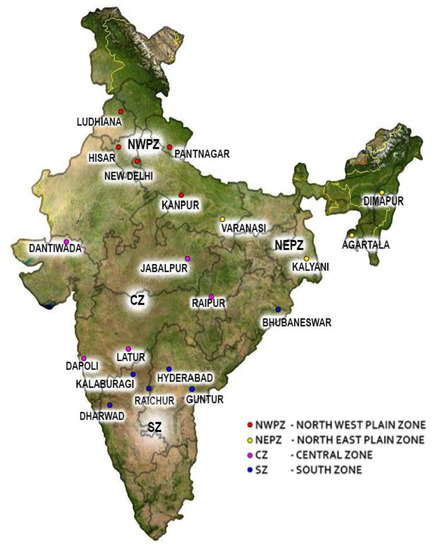
Figure 1.
Sampling locations for collection of field populations of M. vitrata across India.

Table 1.
Sampling details of M. vitrata populations from ecologically diverse pigeonpea growing zones of India.
2.2. Amplification and Sequencing of COI Gene Fragment
The polymerase chain reactions were performed for amplification of the COI gene (partial sequences) using LCO1490 (forward) and HCO2198 (reverse) primers [15]. The master mix (25 µL) contained 2 µL of the template DNA (100 ng), 2.5 µL of PCR buffer (10×), 0.2 µL of Taq polymerase (1U, GeNei™), 1 µL of dNTP mix (2 mM), 1µL of MgCl2 (2 mM), 10 pmol of each primer, and 17.5 µL of nuclease-free water. The amplification was carried out in a thermocycler (BIO-RAD MJ Mini™) programmed for: initial denaturation for 5 min at 94 °C, followed by 30 cycles of denaturation (30 s at 94 °C), annealing (45 s at 50 °C), and extension (1 min at 72 °C). This was followed by a final extension for 10 min at 72 °C. The amplified products were examined on a 1% agarose gel, and the gel purified (GeneJET Gel Extraction Kit, Thermo Scientific, Waltham, MA, USA) PCR products were sequenced using Sanger’s method in an ABI 3730 automated DNA analyzer at M/s Eurofins Analytical Services India Pvt. Ltd., Bengaluru.
2.3. Sequence Data Analyses
The alignment and trimming of the COI sequences was performed in Clustal W (default parameters) in the MEGA 6.0 [20]. The final alignment length was 620 bp. The obtained sequences were confirmed using nBLAST of the National Center for Biotechnology Information (https://www.ncbi.nlm.nih.gov/; accessed on 15 January 2020).) and deposited in the GenBank (Table 1). DnaSP version 5.10.1 software [21] was used to infer various diversity indices, i.e., the number of haplotypes (Hn), haplotype diversity (Hd), nucleotide diversity (π), segregating polymorphic sites (S), and an average number of nucleotide differences among haplotypes (k). Further, to ascertain the demographic history and evolutionary neutrality of the M. vitrata COI sequences, tests such as Fu’s Fs, Tajima’s D, Fu and Li’s D, Fu and Li’s F, and mismatch distribution analysis were also performed using DnaSP 5.10.1. The average pairwise sequence divergences among M. vitrata populations were estimated using the Kimura 2-parameter distance model [22] and displayed graphically in a neighbor-joining (NJ) tree, using MEGA 6.0, with a confidence level of 1000 bootstrap replicates. The average nucleotide base composition of COI sequences and overall mean genetic distance were also calculated with MEGA 6.0. For understanding the genetic structure, the analysis of molecular variance (AMOVA) and pairwise FST values were computed using Arlequin 3.5 [23]. The level of significance was determined with 1000 permutation replicates. Principal coordinates analysis (PCoA) based on the genetic distance matrix and the Mantel test using the pairwise geographical distance (Ln km) against pairwise linearized genetic distance among populations were performed in GenAlEx (version 6.5), with 1000 random permutations [24]. The haplotype network was created using the median-joining algorithm in Network 4.6.1.1 software [25].
3. Results
3.1. Variability in the Mitochondrial COI Gene
The 80 sequences generated in the study showed high similarity (100 percent query coverage and 98 to 100 percent identity) to the M. vitrata COI gene sequences already available in the public domain database (NCBI-GenBank BLASTN search tool). The nucleotide composition in the COI sequences among the populations was found to be very similar, with adenine (A) = 30.93%, cytosine (C) = 15.06%, guanine (G) = 14.62% and thymine (T) = 39.39%, averaged across the multiple sequence alignment (Table 2). The sequence regions also showed comparatively much higher AT (70.32%) over GC (29.68%) content, in accordance with the general patterns in mitochondrial DNA of arthropods. A total of 10 transitions (A = G, T = C) were recorded in the studied sequences but no transversion. The number of haplotypes for the studied population sets from different zones ranged from 3 to 8, with a total of 13 haplotypes recorded from the pooled populations (Table 2). The populations from the Central Zone exhibited comparatively higher haplotype diversity (0.732) and nucleotide diversity (0.00193), as well as an average number of genetic differences among haplotypes (1.216), while the North East Plain Zone population set was lowest in all concerns (Hd = 0.242, π = 0.00060, and k = 0.375). The total nucleotide (π) and haplotype (Hd) diversity were 0.00136 and 0.554, respectively.

Table 2.
Molecular diversity indices and neutrality test values based on COI gene sequences from different M. vitrata populations.
3.2. Demographic Inference and Population Structure
A neutrality test was employed to determine the demographic population history for all the populations across India (Table 2). Tajima’s D value was statistically insignificant for all the zones and the overall population, indicating a low-frequency polymorphism or low levels of genetic variations among these populations. Most of the populations also showed insignificant negative values for Fu and Li’s D and F and Fu’s Fs tests, except those from the North East Plain Zone. The negative deviations from zero in the overall population indicated the occurrence of population growth or expansion in this pest species in the recent past due to an excess of rare mutations. This result was further supported by the smooth and unimodal mismatch distribution plot (Figure 2) that included all the studied populations from varied zones. The AMOVA showed that the majority of total molecular variance (86.09%) was distributed within populations, and only 13.38% and 0.54% were attributed to distribution among populations within zones and among different zones, respectively (Table 3). A non-significant degree of differentiation among groups of populations (FCT = 0.00537, p > 0.10), among populations within groups (FSC = 0.13448, p > 0.05), and among subpopulations within the total population (FST = 0.13912, p > 0.05) indicated the lack of considerable population genetic structure.
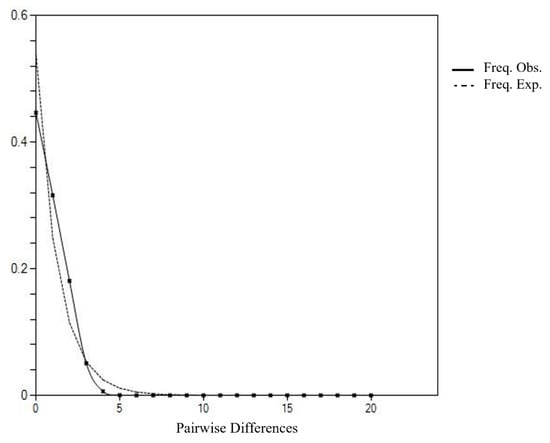
Figure 2.
Frequencies of the observed and expected mismatch distribution in M. vitrata populations of India. X-axis (x), number of pairwise nucleotide differences; Y-axis (y), frequency of mismatches; Freq. Exp., frequency expected (dashed line); and Freq. Obs, frequency observed (solid line).

Table 3.
Analysis of molecular variance (AMOVA) for the COI sequences of different M. vitrata populations.
The overall mean genetic distance was also found to be very low (0.0013 ± 0.001). The principal component analysis (PCoA) showed that the first principal component accounted for 50.59% of the total variation, followed by the second component, which accounted for 21.37% of the variation, and the first three axes explained 86.14% of the cumulative variation (Figure 3). The PCoA roughly separated the populations into three main groups, but there was no clear geographical pattern in the distribution of these populations. Further, the mantel test showed a non-significant and weak correlation between the genetic distance matrix of the studied M. vitrata populations with the corresponding geographic distance matrix (Ln km) (R2 = 0.0024, p = 0.280) (Figure 4) across the study area.
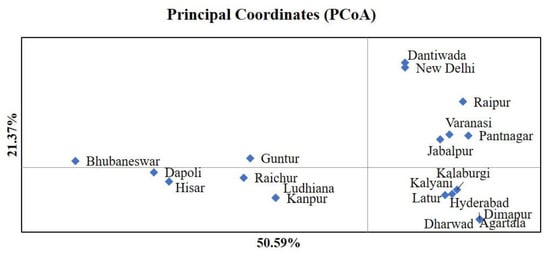
Figure 3.
PCoA analysis score plot of M. vitrata populations from different locations across India based on COI gene.
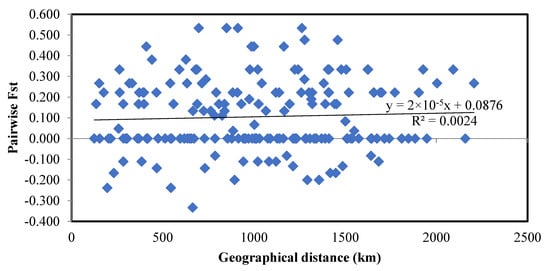
Figure 4.
Correlation between pairwise genetic differentiation using COI gene sequences and geographical distance among the different M. vitrata populations sampled across India.
3.3. Haplotype Distribution and Phylogenetic Analysis
A total of 13 COI haplotypes were identified (80 individuals). The haplotype network was star-like, and different localities shared haplotypes (Figure 5). Haplotype 1 contained 53 M. vitrata individuals and was shared by populations from all locations. It appeared to be the ancestral haplotype, as it had a central position in the network, and all other lineages arose from it. Haplotype 2 formed the second largest group (a total of six individuals) with one individual each from Kanpur, Ludhiana, Hisar, and Dapoli, and two others belonging to Bhubaneswar. Haplotype 6 occurred in individuals collected from New Delhi, Pantnagar, and Raipur. Two individuals from Dantiwada and one each from Jabalpur and Raipur shared haplotype 8. Haplotype 12 included populations only from Guntur. The remaining haplotypes were unique for a single location.
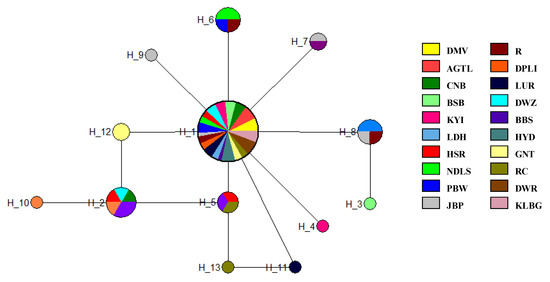
Figure 5.
Median-joining haplotype network of M. vitrata in India based on mitochondrial COI gene. The circle areas are proportional to haplotype frequencies, while the color portions represent the proportions of the same haplotype occurring in each geographical region.
Further, for the phylogenetic comparison of Indian populations with global genetic assemblage, 20 additional COI gene sequences were mined from the NCBI database. These sequences represented populations from 18 different countries outside India, based on the spread of M. vitrata. Topologies of the neighbor-joining tree indicated that all the studied Indian populations belonged to a single major clade (Figure 6). M. vitrata COI gene sequences deposited in the GenBank database from other countries also shared similarities with studied sequences.
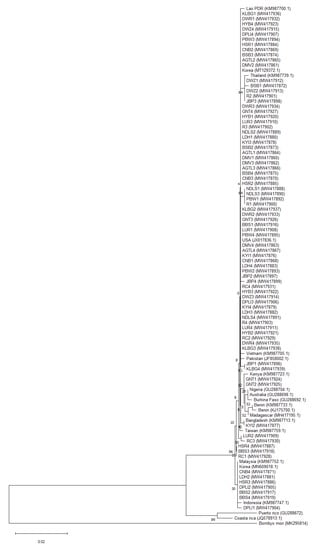
Figure 6.
Neighbor-joining tree based on Kimura 2-parameter distances showing clustering of M. vitrata populations for COI gene. Numbers at branch point indicate 10,000 bootstrap values. Bombyx mori (accession #MK295814) was used as outlier sequence.
4. Discussion
M. vitrata is a key pest of pulses in the Indian subcontinent. The occurrence of this pest has been recorded from various agro-ecological regions of India. In this study, a total of 80 specimens from 20 locations (latitude: 15.49° N to 30.90° N and longitude 72.32° E to 85.81° E) in India were sequenced for COI gene fragments. In population genetic studies of insects, these markers have played an important role [26,27]. They are applicable to the assessment of population genetic structure, identification of unidentified cryptic species, and detection of an alien pest in a new area. Based on the fact that the COI gene has proven to be informative in population genetic studies, we examined the genetic variability using a mitochondrial marker (i.e., COI gene sequences) in an attempt to elucidate the population genetic structure of this pest species in India. The homology search of the COI sequence of each population of M. vitrata with the NCBI sequences confirmed the specimens’ identity. Furthermore, the results showed mean A + T and G + C levels of 70.32% and 29.68%, respectively, confirming the AT-biased nature of the COI gene in M. vitrata, as in other arthropods [1,6,10].
The haplotype diversity (Hd) and nucleotide diversity (π) for all the zones, as well as the overall populations in the present investigation, suggested that the entire population exhibited a low level of genetic diversity. This was in agreement with a previous study that determined the total nucleotide diversity to be 0.00309 for the M. vitrata populations examined across Asia and Africa [10]. Low nucleotide diversity was also exhibited among the Indian (0.00226) and foreign populations (0.00582) [6]. The overall mean genetic distance was also found to be exceptionally low (0.0013), and this strongly supports the single species status of M. vitrata in the country, as a divergence of more than five percent in the COI gene amplicon, i.e., a genetic distance exceeding 0.05, depicts the likely occurrence of a new species in Lepidoptera [16].
The neutrality test indices and genetic differentiation values are helpful in analyzing demographic history, where negative values relate to the demographic expansion of populations after a recent sharp decline, and positive values determine populations subdivided at equilibrium [28,29]. Additionally, Fu’s FS’s negative values are usually associated with “an excess of singletons in a population expansion event” [29,30]. Hence, as per the present study, the Indian population of M. vitrata is predicted to have had recent demographic expansion events depicting an excess of low frequency polymorphism. Our results are consistent with those from the previous study by Periasamy et al. [10], where Tajima’s D test values were non-significant and negative for populations of Asia and Africa. The present investigation is strongly supported by Chatterjee et al. [6] who found a moderate level of polymorphism across global and Indian populations with a positive and statistically significant Tajima’s D value (p < 0.001). However, a statistically insignificant negative Tajima’s D value was observed among the Indian populations, indicating a low-frequency polymorphism.
The genetic variability observed within populations accounted for 86.09%, and only 13.37% and 0.54% of variations were found among populations within the same zone and population sets of different zones, respectively. Low genetic variability among M. vitrata populations using other markers have also been reported by [2,3,9]. Further, no significant correlation was obtained between the genetic variance existing among the studied populations and their respective geographical locations. This reveals that isolation by distance is not always expected in lepidopteran species such as M. vitrata that have high mobility, and this could only be due to the intermingling of populations.
Among the 13 haplotypes identified, haplotype 1 (Hap1), predominantly distributed throughout the Indian populations, comprising 53 samples, is likely the ancestral haplotype among the populations sampled. According to the coalescent theory, common haplotypes at the center of a network are inferred to be ancestral, while tip haplotypes at the periphery are derived or descendant from ancestral haplotypes [31]. In a study undertaken for South and Southeast Asia and sub-Saharan Africa, 64 haplotypes were identified in 686 specimens of M. vitrata [10]. Except for Benin, the most common haplotype included 225 M. vitrata individuals collected from Asian countries. When the populations from each continent were analyzed separately, Oceania had the fewest haplotypes, while Asia had the most. The study also discovered that six out of ten M. vitrata individuals from Jharkhand, India, constituted a distinct haplotype. The present study is also supported by Chatterjee et al. [6], who documented six haplotypes among the populations collected from 11 locations across India. The phylogenetic tree also supported very low genetic heterogeneity in Indian M. vitrata and hinted at the intermingling of populations among diverse agro-ecologies.
There are two probable reasons for the very low genetic variations among Indian populations of M. vitrata. Firstly, it is well documented that several lepidopteran moths have high migratory potential [12]. Thus, because of the substantial gene flow, many of them very often exhibit low genetic differentiation over their wide geographical distributional ranges. In the case of M. vitrata, both the active migration (because of good flight capacity) and passive migration (because of long distance transport of plant materials) might be helping it to maintain a steady state of gene flow, thereby minimizing genetic variation. The previous reports on the ecology and migratory behavior of M. vitrata species across India suggest a gradual shift from North to South India as winter progresses, i.e., during the course of September to December. This can be inferred from the following population dynamics data of the country. The peak activity of M. vitrata from North India has been recorded during October [5,32,33]; in contrast, in southern parts of India, its incidence begins from the third week of November, and the peak is attained during the second fortnight of December [34,35,36]. Such migration can be the cause for higher gene flow among the populations, thereby decreasing the degree of genetic differentiation. The second reason can be that M. vitrata has a very narrow host range feeding mainly on pigeon pea and cowpea in the country. Most of the commercially grown varieties of these crops show slight variation amongst themselves for their susceptibility against this pest species. Thus, there is no selection pressure exerted on this pest due to host plants [37], preventing it from undergoing any genetic changes unlike certain other lepidopterans, mostly from the Noctuidae [38] and Tortricidae [39] families, where the existence of the host-associated genetic differences is widespread.
5. Conclusions
This study provides a clear picture regarding the homogenous genetic structure of M. vitrata in the country. The highly homogenous populations indicate that they are well adapted and migrate freely, which could lead to the concentration of resistant alleles in particular patches, subsequently accelerating the evolution of resistance. This information will be very helpful in designing sustainable management strategies for this pest species in an area-wide manner across India.
Author Contributions
Conceptualization: C.P.S.; methodology: R.M.M.; formal analysis: R.M.M.; investigation: R.M.M.; resources: C.P.S.; data curation: R.M.M., S.C.; writing—original draft preparation: R.M.M.; writing—review and editing: S.C. and C.P.S.; contributed intellectually to the interpretation and discussion of results: C.P.S.; and funding acquisition: C.P.S. All authors have read and agreed to the published version of the manuscript.
Funding
This research received no external funding.
Institutional Review Board Statement
Not applicable.
Informed Consent Statement
Not applicable.
Data Availability Statement
NCBI database gene bank accessions (MW417860-MW417939).
Acknowledgments
We thank Kartikeya Srivastava (Banaras Hindu University, India) for his valuable suggestions during the planning and course of the study.
Conflicts of Interest
The authors declare no conflict of interest.
References
- Agunbiade, T.A.; Coates, B.S.; Sun, W.L.; Tsai, M.R.; Valero, M.C.; Tamò, M.; Pittendrigh, B.R. Comparison of the mitochondrial genomes of the old and new world strains of the legume pod borer, Maruca vitrata (Lepidoptera: Crambidae). Int. J. Trop. Insect Sci. 2017, 37, 125–136. [Google Scholar] [CrossRef]
- Margam, V.M.; Coates, B.S.; Ba, M.N.; Sun, W.; Binso-Dabire, C.L.; Baoua, I.; Ishiyaku, M.F.; Shukle, J.T.; Hellmich, R.L.; Covas, F.G.; et al. Geographic distribution of phylogenetically distinct Legume Pod Borer, Maruca vitrata (Lepidoptera: Pyraloidea: Crambidae). Mol. Biol. Rep. 2011, 38, 893–903. [Google Scholar] [CrossRef] [PubMed]
- Agunbiade, T.A.; Coates, B.S.; Datinon, B.; Djouaka, R.; Sun, W.; Tamò, M.; Pittendrigh, B.R. Genetic Differentiation among Maruca vitrata F. (Lepidoptera: Crambidae) populations on cultivated cowpea and wild host plants: Implications for insect resistance management and biological control strategies. PLoS ONE 2014, 9, e92072. [Google Scholar] [CrossRef] [PubMed]
- Sharma, H.C. Bionomics, host plant resistance, and management of the legume pod borer, Maruca vitrata—A review. Crop Prot. 1998, 17, 373–386. [Google Scholar] [CrossRef]
- Chakravarty, S.; Agnihotri, M.; Jagdish, J. Seasonal abundance of predatory bugs, Eocanthecona furcellata (Wolff.) and Rhynocoris fuscipes (F.) and its olfactory responses towards plant and pest mediated semiochemical cues in pigeonpea ecosystem. Legum. Res. 2017, 40, 351–357. [Google Scholar] [CrossRef]
- Chatterjee, M.; Yadav, J.; Vennila, S.; Shashank, P.R.; Jaiswal, N.; Sreevathsa, R.; Rao, U. Diversity analysis reveals genetic homogeneity among Indian populations of legume pod borer, Maruca vitrata (F.). 3 Biotech 2019, 9, 319. [Google Scholar] [CrossRef]
- Srinivasan, R.; Tamò, M.; Malini, P. Emergence of Maruca vitrata as a major pest of food legumes and evolution of management practices in Asia and Africa. Annu. Rev. Entomol. 2021, 66, 141–161. [Google Scholar] [CrossRef]
- Mahalle, R.; Taggar, G. Insecticides against Maruca vitrata (Fabricius) (Lepidoptera: Crambidae) on pigeonpea. Pestic. Res. J. 2018, 30, 235. [Google Scholar] [CrossRef]
- Sambathkumar, S.; Durairaj, C.; Mohankumar, S.; Preetha, B.; Aravintharaj, R.; Ganapathy, N. Spatial genetic vriation in south Indian larval populations of legume pod borer, Maruca vitrata Geyer (Lepidoptera: Crambidae). Indian J. Exp. Biol. 2019, 57, 923–930. [Google Scholar]
- Periasamy, M.; Schafleitner, R.; Muthukalingan, K.; Ramasamy, S. Phylogeographical structure in mitochondrial DNA of legume pod borer (Maruca vitrata) population in tropical Asia and Sub-Saharan Africa. PLoS ONE 2015, 10, e0124057. [Google Scholar] [CrossRef][Green Version]
- Malini, P.; Ramasamy, S.; Schafleitner, R.; Muthukalingan, K. Pheromone-binding proteins based phylogenetics and phylogeography of Maruca spp. from Asia, Africa, Oceania, and South America. Ecol. Evol. 2019, 9, 9239–9272. [Google Scholar] [CrossRef] [PubMed]
- Chakravarty, S.; Padwal, K.P.; Srivastava, C.P. Molecular Characterization of intraspecific variations in Helicoverpa armigera (Hübner) populations across India. J. Environ. Biol. 2021, 42, 1320–1329. [Google Scholar] [CrossRef]
- Karthika, P.; Vadivalagan, C.; Thirumurugan, D.; Murugan, K. Intra-species variation and geographic differentiation among the populations of the quarantine agricultural pest Leucinoides orbonalis (Lepidoptera: Crambidae) in the global assemblage—A prospective of DNA barcoding. Mitochondrial DNA Part A 2019, 30, 682–693. [Google Scholar] [CrossRef] [PubMed]
- Hebert, P.D.N.; Cywinska, A.; Ball, S.L.; deWaard, J.R. Biological identifications through DNA barcodes. Proc. Biol. Sci. 2003, 270, 313–321. [Google Scholar] [CrossRef]
- Folmer, O.; Black, M.; Hoeh, W.; Lutz, R.; Vrijenhoek, R. DNA Primers for amplification of mitochondrial cytochrome c oxidase subunit I from diverse metazoan invertebrates. Mol. Mar. Biol. Biotechnol. 1994, 3, 294–299. [Google Scholar] [PubMed]
- Hebert, P.D.N.; deWaard, J.R.; Landry, J.F. DNA Barcodes for 1/1000 of the animal kingdom. Biol. Lett. 2010, 6, 359–362. [Google Scholar] [CrossRef] [PubMed]
- Shashank, P.R.; Thomas, A.; Ramamurthy, V.V. DNA Barcoding and Phylogenetic Relationships of Spodoptera litura and S. exigua (Lepidoptera: Noctuidae). Fla. Entomol. 2015, 98, 223–228. [Google Scholar] [CrossRef]
- Padwal, K.G.; Chakravarty, S.; Srivastava, C.P. Genetic variability and population structure of Leucinodes orbonalis (Guenée), a severe insect pest of brinjal in India. J. Environ. Biol. 2022, 43, 59–65. [Google Scholar] [CrossRef]
- Murray, M.G.; Thompson, W.F. Rapid isolation of high molecular weight plant DNA. Nucleic Acids Res. 1980, 8, 4312–4325. [Google Scholar] [CrossRef]
- Tamura, K.; Stecher, G.; Peterson, D.; Filipski, A.; Kumar, S. MEGA6: Molecular evolutionary genetics analysis version 6.0. Mol. Biol. Evol. 2013, 30, 2725–2729. [Google Scholar] [CrossRef]
- Librado, P.; Rozas, J. DnaSP v5: A software for comprehensive analysis of DNA polymorphism data. Bioinformatics 2009, 25, 1451–1452. [Google Scholar] [CrossRef] [PubMed]
- Kimura, M. A simple method for estimating evolutionary rates of base substitutions through comparative studies of nucleotide sequences. J. Mol. Evol. 1980, 16, 111–120. [Google Scholar] [CrossRef] [PubMed]
- Excoffier, L.; Lischer, H.E.L. Arlequin Suite Ver 3.5: A new series of programs to perform population genetics analyses under Linux and Windows. Mol. Ecol. Resour. 2010, 10, 564–567. [Google Scholar] [CrossRef] [PubMed]
- Peakall, R.; Smouse, P.E. GenAlEx 6.5: Genetic analysis in excel. Population genetic software for teaching and research—An update. Bioinformatics 2012, 28, 2537–2539. [Google Scholar] [CrossRef] [PubMed]
- Bandelt, H.J.; Forster, P.; Röhl, A. Median-joining networks for inferring intraspecific phylogenies. Mol. Biol. Evol. 1999, 16, 37–48. [Google Scholar] [CrossRef] [PubMed]
- Sridhar, J.; Chinna Babu Naik, V.; Ghodke, A.; Kranthi, S.; Kranthi, K.R.; Singh, B.P.; Choudhary, J.S.; Krishna, M.S.R. Population genetic structure of cotton pink bollworm, Pectinophora gossypiella (Saunders) (Lepidoptera: Gelechiidae) using mitochondrial cytochrome oxidase I (COI) gene sequences from India. Mitochondrial DNA Part A 2017, 28, 941–948. [Google Scholar] [CrossRef] [PubMed]
- Arias, M.C.; Sheppard, W.S. Phylogenetic relationships of honey bees (Hymenoptera: Apinae: Apini) inferred from nuclear and mitochondrial DNA sequence data. Mol. Phylogenet. Evol. 2005, 37, 25–35. [Google Scholar] [CrossRef]
- Tajima, F. Statistical method for testing the neutral mutation hypothesis by DNA polymorphism. Genetics 1989, 123, 585–595. [Google Scholar] [CrossRef]
- Fu, Y.X. Statistical tests of neutrality of mutations against population growth, hitchhiking and background selection. Genetics 1997, 147, 915–925. [Google Scholar] [CrossRef]
- Fu, Y.X. Statistical properties of segregating sites. Theor. Popul. Biol. 1995, 48, 172–197. [Google Scholar] [CrossRef]
- Hudson, R.R. Gene genealogies and the coalescent process. In Oxford Surveys in Evolutionary Biology; Futuyuma, D., Antonouics, J., Eds.; Oxford University Press: New York, NY, USA, 1990; Volume 7, pp. 1–44. [Google Scholar]
- Srivastava, C.P.; Pimbert, M.P.; Jadhav, D.R. Monitoring adult populations of Maruca testulalis (Geyer) with light traps at Patancheru and Hisar in India. Int. Pigeonpea Newsl. 1992, 15, 27–28. [Google Scholar]
- Taggar, G.K.; Singh, R.; Cheema, H.K.; Singh, P. Relative abundance, population dynamics and damage potential of spotted pod borer, Maruca vitrata (Fabricius) on early pigeonpea in Punjab. Int. J. Trop. Insect Sci. 2019, 39, 229–234. [Google Scholar] [CrossRef]
- Chaitanya, T.; Sreedevi, K.; Navatha, L.; Krishna, T.M.; Prasanti, L. Bionomics and population dynamics of legume pod borer, Maruca vitrata (Geyer) in Cajanus cajan (L.) Millsp. Curr. Biot. 2012, 5, 446–453. [Google Scholar]
- Sreekanth, M.; Ratnam, M.; Seshamahalakshmi, M.; Rao, Y.K.; Narayana, E. Population build-up and seasonal abundance of spotted pod borer, Maruca vitrata (Geyer) on pigeonpea (Cajanus cajan (L) Millsp.). J. App. Biol. Biotechnol. 2015, 3, 43–45. [Google Scholar] [CrossRef]
- Sampathkumar, S.; Durairaj, C. Relative abundance of legume pod borer, Maruca vitrata Geyer (Lepidoptera: Crambidae) on pigeonpea and its relationship with weather parameters. Madras Agric. J. 2015, 102, 67–70. [Google Scholar]
- Sambathkumar, S.; Durairaj, C.; Mohankumar, S.; Preetha, B.; Aravintharaj, R.; Ganapathy, N.; Surendran, R. Host induced genetic variation in legume pod borer, Maruca Vitrata. J. Environ. Biol. 2017, 38, 1281–1291. [Google Scholar] [CrossRef]
- Subramanian, S.; Mohankumar, S. Genetic variability of the bollworm, Helicoverpa armigera, occurring on different host plants. J. Insect Sci. 2006, 6, 26. [Google Scholar] [CrossRef] [PubMed][Green Version]
- Emelianov, I.; Mallet, J.; Baltensweiler, W. Genetic differentiation in Zeiraphera diniana (Lepidoptera: Tortricidae, the Larch budmoth): Polymorphism, host races or sibling species? Heredity 1995, 75, 416–424. [Google Scholar] [CrossRef]
Publisher’s Note: MDPI stays neutral with regard to jurisdictional claims in published maps and institutional affiliations. |
© 2022 by the authors. Licensee MDPI, Basel, Switzerland. This article is an open access article distributed under the terms and conditions of the Creative Commons Attribution (CC BY) license (https://creativecommons.org/licenses/by/4.0/).